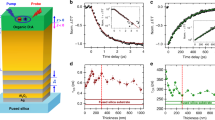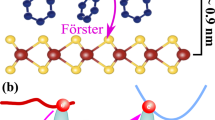Abstract
Charge transfer (CT) is a fundamental and ubiquitous mechanism in biology, physics and chemistry. Here, we evidence that CT dynamics can be altered by multi-layered hyperbolic metamaterial (HMM) substrates. Taking triphenylene:perylene diimide dyad supramolecular self-assemblies as a model system, we reveal longer-lived CT states in the presence of HMM structures, with both charge separation and recombination characteristic times increased by factors of 2.4 and 1.7—that is, relative variations of 140 and 73%, respectively. To rationalize these experimental results in terms of driving force, we successfully introduce image dipole interactions in Marcus theory. The non-local effect herein demonstrated is directly linked to the number of metal–dielectric pairs, can be formalized in the dielectric permittivity, and is presented as a solid analogue to local solvent polarity effects. This model and extra PH3T:PC60BM results show the generality of this non-local phenomenon and that a wide range of kinetic tailoring opportunities can arise from substrate engineering. This work paves the way toward the design of artificial substrates to control CT dynamics of interest for applications in optoelectronics and chemistry.
This is a preview of subscription content, access via your institution
Access options
Access Nature and 54 other Nature Portfolio journals
Get Nature+, our best-value online-access subscription
$29.99 / 30 days
cancel any time
Subscribe to this journal
Receive 12 print issues and online access
$259.00 per year
only $21.58 per issue
Buy this article
- Purchase on Springer Link
- Instant access to full article PDF
Prices may be subject to local taxes which are calculated during checkout





Similar content being viewed by others
References
Marcus, R. A. Electron transfer reations in chemistry. Theory and experiment. Rev. Mod. Phys. 65, 599–610 (1993).
Marcus, R. A. Electron transfer theory and its inception. Phys. Chem. Chem. Phys. 14, 13729–13730 (2012).
Perrin, M. L. et al. Large tunable image-charge effects in single-molecule junctions. Nat. Nanotech. 8, 282–287 (2013).
Jailaubekov, A. E. et al. Hot charge-transfer excitons set the time limit for charge separation at donor/acceptor interfaces in organic photovoltaics. Nat. Mater. 12, 66–73 (2013).
Lunkenheimer, P. et al. Multiferroicity in an organic charge-transfer salt that is suggestive of electric-dipole-driven magnetism. Nat. Mater. 11, 755–758 (2012).
Lambert, N. et al. Quantum biology. Nat. Phys. 9, 10–18 (2012).
Canaguier-Durand, A. et al. Thermodynamics of molecules strongly coupled to the vacuum field. Angew. Chem. Int. Ed. 52, 10533–10536 (2013).
Clavero, C. Plasmon-induced hot-electron generation at nanoparticle/metal-oxide interfaces for photovoltaic and photocatalytic devices. Nat. Photon. 8, 95–103 (2014).
Kavarnos, G. J. & Turro, N. J. Photosensitization by reversible electron transfer: theories, experimental evidence, and examples. Chem. Rev. 86, 401–449 (1986).
Oevering, H. et al. Long-range photoinduced through-bond electron transfer and radiative recombination via rigid nonconjugated bridges: distance and solvent dependence. J. Am. Chem. Soc. 109, 3258–3269 (1987).
Rosspeintner, A. & Vauthey, E. Bimolecular photoinduced electron transfer reactions in liquids under the gaze of ultrafast spectroscopy. Phys. Chem. Chem. Phys. 16, 25741–25754 (2014).
Coropceanu, V. et al. Charge transport in organic semiconductors. Chem. Rev. 107, 926–952 (2007).
Sokolov, A. N. et al. From computational discovery to experimental characterization of a high hole mobility organic crystal. Nat. Commun. 2, 437–445 (2011).
Ribierre, J. C. et al. Hybrid organic-inorganic liquid bistable memory devices. Org. Electron. 12, 1800–1805 (2011).
Gorczak, N. et al. Different mechanisms for hole and electron transfer along identical molecular bridges: the importance of the initial state delocalization. J. Phys. Chem. A 118, 3891–3898 (2014).
Dimitrov, S. D. & Durrant, J. R. Materials design considerations for charge generation in organic solar cells. Chem. Mater. 26, 616–630 (2014).
Kim, R. H. et al. Non-volatile organic memory with sub-millimetre bending radius. Nat. Commun. 5, 3583–3595 (2014).
Muhieddine, K. et al. All solution-processed, hybrid light emitting field-effect transistors. Adv. Mater. 26, 6410–6415 (2014).
La, O. V. C. et al. Elucidating the role of disorder and free-carrier recombination kinetics in CH3NH3PbI3 perovskite films. Nat. Commun. 6, 7903–7910 (2015).
Hirata, S. et al. Highly efficient blue electroluminescence based on thermally activated delayed fluorescence. Nat. Mater. 14, 330–336 (2015).
Howells, C. T. et al. Enhanced organic solar cells efficiency through electronic and electro-optic effects resulting from charge transfers in polymer hole transport blends. J. Mater. Chem. A 4, 4252–4263 (2016).
Orgiu, E. et al. Conductivity in organic semiconductors hybridized with the vacuum field. Nat. Mater. 14, 1123–1129 (2015).
Hutchison, J. A. et al. Modifying chemical landscapes by coupling to vacuum fields. Angew. Chem. Int. Ed. 51, 1592–1596 (2012).
Feist, J. & Garcia-Vidal, F. J. Extraordinary exciton conductance induced by strong coupling. Phys. Rev. Lett. 114, 196402 (2015).
Dai, S. et al. Graphene on hexagonal boron nitride as a tunable hyperbolic metamaterial. Nat. Nanotech. 10, 682–686 (2015).
Krishnamoorthy, H. N. et al. Topological transitions in metamaterials. Science 336, 205–209 (2012).
Poddubny, A. et al. Hyperbolic metamaterials. Nat. Photon. 7, 948–957 (2013).
Kildishev, A. V. et al. Planar photonics with metasurfaces. Science 339, 1232009 (2013).
Zhukovsky, S. V. et al. Physical nature of volume plasmon polaritons in hyperbolic metamaterials. Opt. Express 21, 14982–14987 (2013).
Lu, D. & Liu, Z. Hyperlenses and metalenses for far-field super-resolution imaging. Nat. Commun. 3, 1205–1214 (2012).
Hunt, J. et al. Metamaterial apertures for computational imaging. Science 339, 310–313 (2013).
Shitrit, N. et al. Spin-optical metamaterial route to spin-controlled photonics. Science 340, 724–726 (2013).
Lee, Y. U. & Wu, J. W. Control of optical spin Hall shift in phase-discontinuity metasurface by weak value measurement post-selection. Sci. Rep. 5, 13900 (2015).
Kauranen, M. & Zayats, A. V. Nonlinear plasmonics. Nat. Photon. 6, 737–748 (2012).
Zheng, G. et al. Metasurface holograms reaching 80% efficiency. Nat. Nanotech. 10, 308–312 (2015).
Sondergaard, T. et al. Plasmonic black gold by adiabatic nanofocusing and absorption of light in ultra-sharp convex grooves. Nat. Commun. 3, 969 (2012).
Hu, H. et al. Rainbow trapping in hyperbolic metamaterial waveguide. Sci. Rep. 3, 1249 (2013).
Esfandyarpour, M. et al. Metamaterial mirrors in optoelectronic devices. Nat. Nanotech. 9, 542–547 (2014).
Ni, X. et al. Effect of metallic and hyperbolic metamaterial surfaces on electric and magnetic dipole emission transitions. Appl. Phys. B 103, 553–558 (2011).
Noginova, N. et al. Modification of electric and magnetic dipole emission in anisotropic plasmonic systems. Opt. Express 21, 23087–23096 (2013).
Noginov, M. A. et al. Controlling spontaneous emission with metamaterials. Opt. Lett. 35, 1863–1865 (2010).
Tumkur, T. et al. Control of spontaneous emission in a volume of functionalized hyperbolic metamaterial. Appl. Phys. Lett. 99, 151115 (2011).
Kim, J. et al. Improving the radiative decay rate for dye molecules with hyperbolic metamaterials. Opt. Express 20, 8100–8116 (2012).
Lu, D. et al. Enhancing spontaneous emission rates of molecules using nanopatterned multilayer hyperbolic metamaterials. Nat. Nanotech. 9, 48–53 (2014).
Peters, V. N. et al. Control of a chemical reaction (photodegradation of the p3ht polymer) with nonlocal dielectric environments. Sci. Rep. 5, 14620 (2015).
Cortes, C. L. et al. Quantum nanophotonics using hyperbolic metamaterials. J. Opt. 14, 063001 (2012).
Schilling, J. Uniaxial metallo-dielectric metamaterials with scalar positive permeability. Phys. Rev. E 74, 046618 (2006).
Elemans, J. A. A. W. et al. Molecular materials by self-assembly of porphyrins, phthalocyanines, and perylenes. Adv. Mater. 18, 1251–1266 (2006).
Hayashi, H. et al. Segregated donor-acceptor columns in liquid crystals that exhibit highly efficient ambipolar charge transport. J. Am. Chem. Soc. 133, 10736–10739 (2011).
Schwartz, P. O. et al. Perylenediimide-based donor-acceptor dyads and triads: impact of molecular architecture on self-assembling properties. J. Am. Chem. Soc. 136, 5981–5992 (2014).
Squillaci, M. A. et al. Self-assembly of an amphiphilic pi-conjugated dyad into fibers: ultrafast and ultrasensitive humidity sensor. Adv. Mater. 27, 3170–3174 (2015).
Zhao, K. Q. et al. Highly segregated lamello-columnar mesophase organizations and fast charge carrier mobility in new discotic donor-acceptor triads. Chem. Eur. J. A 21, 10379–10390 (2015).
Xiao, Y. et al. Chemical engineering of donor-acceptor liquid crystalline dyads and triads for the controlled nanostructuration of organic semiconductors. CrystEngComm. 18, 4787–4798 (2016).
Lee, K. J. et al. Structure–charge transfer property relationship in self-assembled discotic liquid-crystalline donor–acceptor dyad and triad thin films. RSC Adv. 6, 57811–57819 (2016).
Zhu, X. Y. How to draw energy level diagrams in excitonic solar cells. J. Phys. Chem. Lett. 5, 2283–2288 (2014).
Chen, L. X. et al. Dynamics of photoinduced electron transfer in a molecular donor-acceptor quartet. J. Phys. Chem. B 110, 11730–11738 (2006).
Roland, T. et al. Sub-100 fs charge transfer in a novel donor-acceptor-donor triad organized in a smectic film. Phys. Chem. Chem. Phys. 14, 273–279 (2012).
Sartin, M. M. et al. Nonlinear optical pulse suppression via ultrafast photoinduced electron transfer in an aggregated perylene diimide/oligothiophene molecular triad. J. Phys. Chem. A 118, 110–121 (2014).
Acknowledgements
This work has been carried out in the framework of CNRS International Associated Laboratory ‘Functional nanostructures: morphology, nanoelectronics and ultrafast optics’ (LIA NANOFUNC). K.J.L., Y.X., J.H.W., E.K., J.-C.R., J.W.W. and P.A. were supported by funding of the Ministry of Science, ICT & Future Planning, Korea (201000453, 2015001948, 2014M3A6B3063706). P.A. would like to thank the Canon Foundation in Europe for supporting his Fellowship. The authors also acknowledge the International Research Network (GDRI, CNRS) on ‘Functional Materials for Organic Optics, Electronics and Devices’ (FUNMOOD). The authors are also grateful to J.-Y. Bigot, M. Vomir, M. Barthelemy and O. Cregut for their contributions in setting up and optimizing the femtosecond pump–probe set-up used in this study. The authors thank Pohang Accelerator Laboratory (PAL) in South Korea for giving us the opportunity to perform the GIXS measurements in the frame of the proposal number ‘2014-1st-9A-015’. The authors are grateful to MEST and POSTECH for supporting the GIXS experiments, to T. J. Shin and H. Ahn as well as other staff members from 9A U-SAXS beamline for assistance with adjustments and help. B. Heinrich is warmly acknowledged for his contributions to the GIXS measurements and data analysis.
Author information
Authors and Affiliations
Contributions
K.J.L., J.-C.R., J.W.W. and P.A. designed the experiments; Y.X. synthesized the dyad molecules under the supervision of F.M., D.K. and A.-J.A.; Y.X., BH and F.M. completed the GIXS measurements. K.J.L. completed the transient measurements and analysis with some assistance from J.H.W. and E.K., and with feedback from P.A.; K.J.L., J.W.W. and P.A. developed the model used to describe the system and discussed the results. K.J.L. completed all the numerical calculations. K.J.L. and P.A. prepared the figures. P.A. wrote the manuscript and Supplementary Information, except the GIXS and dyad preparation. K.J.L., J.-C.R., J.W.W. and P.A. replied to the reviewer comments and altered the manuscript accordingly. All the authors commented on the manuscript.
Corresponding authors
Ethics declarations
Competing interests
The authors declare no competing financial interests.
Supplementary information
Supplementary Information
Supplementary Information (PDF 1537 kb)
Rights and permissions
About this article
Cite this article
Lee, K., Xiao, Y., Woo, J. et al. Charge-transfer dynamics and nonlocal dielectric permittivity tuned with metamaterial structures as solvent analogues. Nature Mater 16, 722–729 (2017). https://doi.org/10.1038/nmat4907
Received:
Accepted:
Published:
Issue Date:
DOI: https://doi.org/10.1038/nmat4907
This article is cited by
-
Gigantic suppression of recombination rate in 3D lead-halide perovskites for enhanced photodetector performance
Nature Photonics (2023)
-
H-shaped modifiers loaded mirror symmetric resonator based double negative metamaterial for multi-band wireless communications
Scientific Reports (2023)
-
Symmetric resonator based tunable epsilon negative near zero index metamaterial with high effective medium ratio for multiband wireless applications
Scientific Reports (2021)
-
Nanoporous gold nanoleaf as tunable metamaterial
Scientific Reports (2021)
-
Optical-field driven charge-transfer modulations near composite nanostructures
Nature Communications (2020)



